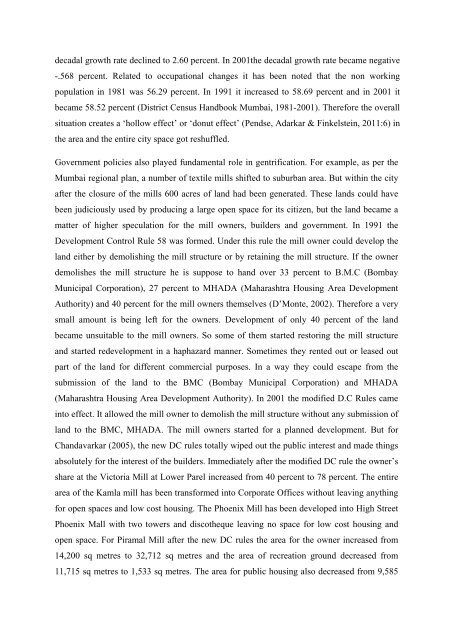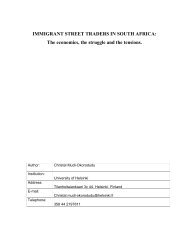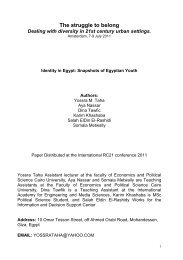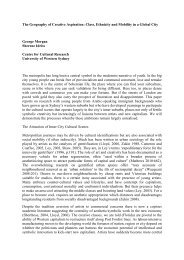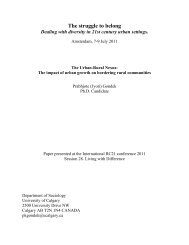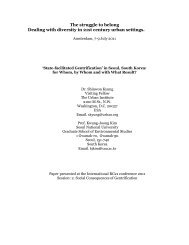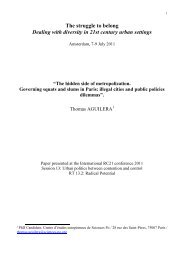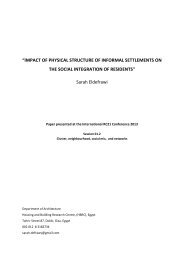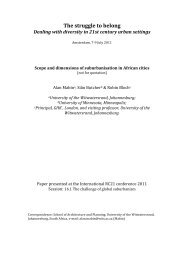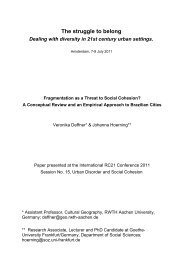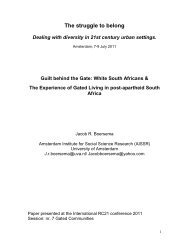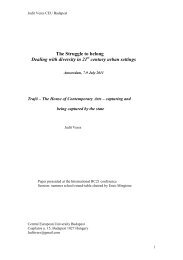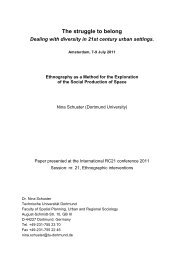Gentrification in the mill land areas of Mumbai city - RC21 ORG ...
Gentrification in the mill land areas of Mumbai city - RC21 ORG ...
Gentrification in the mill land areas of Mumbai city - RC21 ORG ...
Create successful ePaper yourself
Turn your PDF publications into a flip-book with our unique Google optimized e-Paper software.
decadal growth rate decl<strong>in</strong>ed to 2.60 percent. In 2001<strong>the</strong> decadal growth rate became negative<br />
-.568 percent. Related to occupational changes it has been noted that <strong>the</strong> non work<strong>in</strong>g<br />
population <strong>in</strong> 1981 was 56.29 percent. In 1991 it <strong>in</strong>creased to 58.69 percent and <strong>in</strong> 2001 it<br />
became 58.52 percent (District Census Handbook <strong>Mumbai</strong>, 1981-2001). Therefore <strong>the</strong> overall<br />
situation creates a ‘hollow effect’ or ‘donut effect’ (Pendse, Adarkar & F<strong>in</strong>kelste<strong>in</strong>, 2011:6) <strong>in</strong><br />
<strong>the</strong> area and <strong>the</strong> entire <strong>city</strong> space got reshuffled.<br />
Government policies also played fundamental role <strong>in</strong> gentrification. For example, as per <strong>the</strong><br />
<strong>Mumbai</strong> regional plan, a number <strong>of</strong> textile <strong>mill</strong>s shifted to suburban area. But with<strong>in</strong> <strong>the</strong> <strong>city</strong><br />
after <strong>the</strong> closure <strong>of</strong> <strong>the</strong> <strong>mill</strong>s 600 acres <strong>of</strong> <strong>land</strong> had been generated. These <strong>land</strong>s could have<br />
been judiciously used by produc<strong>in</strong>g a large open space for its citizen, but <strong>the</strong> <strong>land</strong> became a<br />
matter <strong>of</strong> higher speculation for <strong>the</strong> <strong>mill</strong> owners, builders and government. In 1991 <strong>the</strong><br />
Development Control Rule 58 was formed. Under this rule <strong>the</strong> <strong>mill</strong> owner could develop <strong>the</strong><br />
<strong>land</strong> ei<strong>the</strong>r by demolish<strong>in</strong>g <strong>the</strong> <strong>mill</strong> structure or by reta<strong>in</strong><strong>in</strong>g <strong>the</strong> <strong>mill</strong> structure. If <strong>the</strong> owner<br />
demolishes <strong>the</strong> <strong>mill</strong> structure he is suppose to hand over 33 percent to B.M.C (Bombay<br />
Municipal Corporation), 27 percent to MHADA (Maharashtra Hous<strong>in</strong>g Area Development<br />
Authority) and 40 percent for <strong>the</strong> <strong>mill</strong> owners <strong>the</strong>mselves (D’Monte, 2002). Therefore a very<br />
small amount is be<strong>in</strong>g left for <strong>the</strong> owners. Development <strong>of</strong> only 40 percent <strong>of</strong> <strong>the</strong> <strong>land</strong><br />
became unsuitable to <strong>the</strong> <strong>mill</strong> owners. So some <strong>of</strong> <strong>the</strong>m started restor<strong>in</strong>g <strong>the</strong> <strong>mill</strong> structure<br />
and started redevelopment <strong>in</strong> a haphazard manner. Sometimes <strong>the</strong>y rented out or leased out<br />
part <strong>of</strong> <strong>the</strong> <strong>land</strong> for different commercial purposes. In a way <strong>the</strong>y could escape from <strong>the</strong><br />
submission <strong>of</strong> <strong>the</strong> <strong>land</strong> to <strong>the</strong> BMC (Bombay Municipal Corporation) and MHADA<br />
(Maharashtra Hous<strong>in</strong>g Area Development Authority). In 2001 <strong>the</strong> modified D.C Rules came<br />
<strong>in</strong>to effect. It allowed <strong>the</strong> <strong>mill</strong> owner to demolish <strong>the</strong> <strong>mill</strong> structure without any submission <strong>of</strong><br />
<strong>land</strong> to <strong>the</strong> BMC, MHADA. The <strong>mill</strong> owners started for a planned development. But for<br />
Chandavarkar (2005), <strong>the</strong> new DC rules totally wiped out <strong>the</strong> public <strong>in</strong>terest and made th<strong>in</strong>gs<br />
absolutely for <strong>the</strong> <strong>in</strong>terest <strong>of</strong> <strong>the</strong> builders. Immediately after <strong>the</strong> modified DC rule <strong>the</strong> owner’s<br />
share at <strong>the</strong> Victoria Mill at Lower Parel <strong>in</strong>creased from 40 percent to 78 percent. The entire<br />
area <strong>of</strong> <strong>the</strong> Kamla <strong>mill</strong> has been transformed <strong>in</strong>to Corporate Offices without leav<strong>in</strong>g anyth<strong>in</strong>g<br />
for open spaces and low cost hous<strong>in</strong>g. The Phoenix Mill has been developed <strong>in</strong>to High Street<br />
Phoenix Mall with two towers and disco<strong>the</strong>que leav<strong>in</strong>g no space for low cost hous<strong>in</strong>g and<br />
open space. For Piramal Mill after <strong>the</strong> new DC rules <strong>the</strong> area for <strong>the</strong> owner <strong>in</strong>creased from<br />
14,200 sq metres to 32,712 sq metres and <strong>the</strong> area <strong>of</strong> recreation ground decreased from<br />
11,715 sq metres to 1,533 sq metres. The area for public hous<strong>in</strong>g also decreased from 9,585


